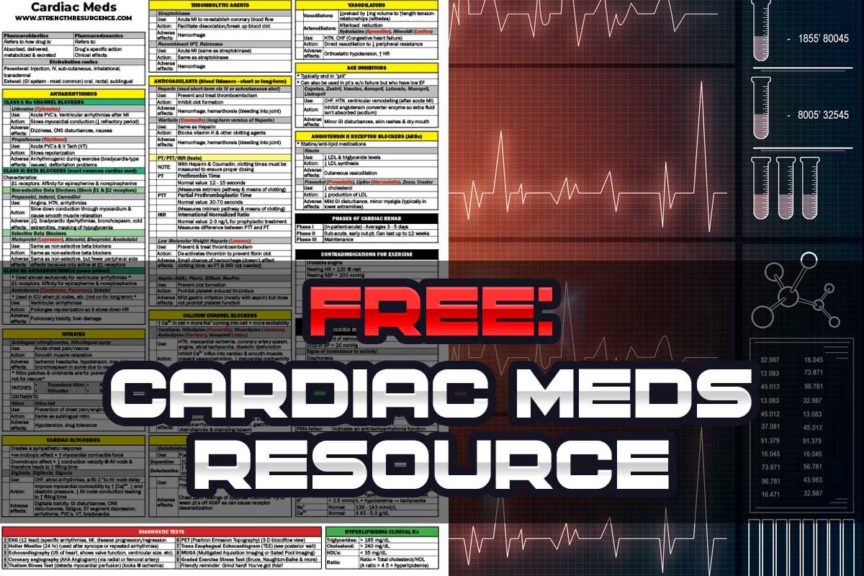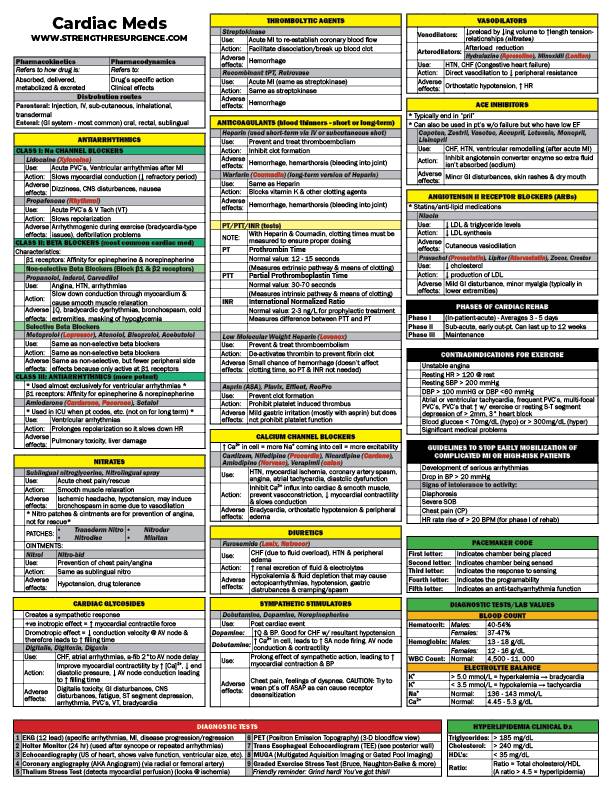*To get the free one-page cardiac meds cheat sheet, please click on the link at the bottom of this post!*
Within this blog post, you will find a free, cardiac medications sheet that I made for myself back in my days of PT school. I’m sharing it with you for free to hopefully lighten up your stress load in some way, shape or form. Please see my small disclaimer at the bottom of this blog post right above the download link.
Learning cardiac medications can be a grind.
Learning all of the different categories and classifications of cardiac medications can be a tall order for a lot of students when in school. If you find yourself struggling to retain the vast array of information, one of the ways I’d like to help is by providing a free cheat sheet/one-page resource sheet as you commit to your studies.
There are PLENTY of amazing videos that other healthcare professionals have created online in order to provide amazing study tips and great ways to memorize basic cardiac medications. Because of this, I won’t delve too deep into study tips within this blog post when so many others have already done such a great job – BUT I believe that having a nice, consolidated one-page study sheet can really help aid in your studying pursuits, and I’ll provide a bit more detail as to why:
Why study sheets can greatly aid in your pursuit of learning cardiac medications
When it comes to studying medications, one of the many challenges that students face pertains to the fact that there’s just a lot of ground to cover with medications. You need to learn the names of medications, their classifications, what they’re taken for, adverse effects and so on.
What can make this so challenging is that there can be little rhyme or reason to the medication names, which often means nothing short of mind-numbingly long sessions of repetition and rote memorization to pound them into your brain.
For me, this is where a consolidated, one-page study sheet would always come in handy. I ALWAYS laminated these sheets that I would make, and then carry them around just about everywhere, glancing at them the moment I had a free second in order to further pound information into my head.
Don’t get me wrong, I often relied heavily on great websites and other resources, including YouTube videos, but a study sheet served me well since I could take it everywhere, and extract the pertinent information from it instantly the second that I glanced at it. But alas, my days of PT school are behind me, so it only makes sense to take the study sheets I made and provide them to other students who now find themselves grinding hard to get through their respective academic coursework.
Laminating your study sheets is a good move to make
It may cost a couple of dollars to laminate any study sheet you use, but it’s well worth it. By laminating it, you can use a non-permanent marker to tick off the boxes, cross things out, etc. Then you can clean it and do it all over again if needed.
You can also tuck them into your textbooks or binders, and take them anywhere. They hold up remarkably well. You certainly don’t have to do this, but for me, it just always made sense – otherwise, they’d get wrinkled up and break down within a very short period of time.
How to read over this study sheet
I’ve mentioned this in the YouTube video, but if you haven’t yet watched the video, here’s the breakdown of how the sheet works:
- Any box with a yellow bar represents a classification of drug, such as drugs that are used for cardiac arrhythmias, or drugs that are used for hypertension, or drugs used for vasodilation, etc.
- Some of these boxes will have green colored boxes (i.e. for the arrythmia drug category), which just splits up this category into three different classes within the category.
- Within each of those boxes you’ll see a grey row, which provides names of common medications within that category. Drug names listed in black tend to be generic names while drugs labelled with red text are an example of the drug’s trade name.
- For each category of drug you’ll see a universal layout for describing the drug’s general use, it’s action as well as common adverse effects when taken.
- The sheet also includes some quick information pertaining to phases of cardiac rehab, contraindications for exercise (in regards to patients with compromised cardiac function), guidelines for stopping exercise for these patients, as well as information pertaining to pacemaker codes and some clinical lab values.
- You’ll also see a red box at the bottom of the sheet that just quickly mentions some of the more common diagnostic tests used within the world of cardiac diagnostic testing.
Some very quick tips for beginning to memorize cardiac medications
Again, I won’t go into a ton of detail here on tips and tricks, but here are a couple of really quick things worth mentioning as you begin to study the world of cardiac meds:
- Beta blockers are the most commonly prescribed cardiac medication, and the names of these medications tend to end with “lol” such as Propanolol, Inderol, Carvedilol. One tip many students use to remember this is through saying that the names of beta blocker medications are really funny and therefore make them want to Laugh Out Loud (LOL – for those of you who aren’t up to speed with texting abbreviations).
- ACE (angiotensin converting enzyme) medications tend to end with the letters “pril”. Ace inhibitors are also fairly common cardiac medications. So if you see or hear a medication ending in “pril”, there’s a good chance that it’s an ACE inhibitor (such as Accupril, Monopril, Lisinopril among others).
- Drugs that have a name ending in “statin” refer to medications that are used to lower cholesterol levels within individuals.
One quick, final reminder
It’s important to keep in mind that this sheet is by no means a complete sheet covering all the different medications for each category or classification of cardiac drugs. In addition to that, I created this study sheet largely from my class notes pertaining to my cardiopulmonary rehab class within PT school – therefore the information contained within the sheet may be slightly different than what you’re being taught within your schooling or what you need to know. The sheet met my needs in regards to what I needed it for (i.e. I originally built it for myself back in my days of school for my own individual needs).
Therefore, I make no guarantees that everything within this sheet will meet any or all of your needs. I certainly hope that it does, but if you have any doubts pertaining to the accuracy of any material within it, please consult with your respective professor(s) or academic instructor(s).
Need another great FREE Resource? Check out my Musculoskeletal Innervations cheat sheet! (click/tap link to get it!)
With that being said, here is the link: Click this link to download the Cardiac Meds PDF document! Once the page opens up, right-click to save it or click the download icon on the upper right-hand corner of your screen!
Grind hard. You’ve got this!
-Jim

Hi! I’m Jim Wittstrom, PT, DPT, CSCS, Pn1.
I am a physical therapist who is passionate about all things pertaining to strength & conditioning, human movement, injury prevention and rehabilitation. I created StrengthResurgence.com in order to help others become stronger and healthier. I also love helping aspiring students and therapists fulfill their dreams of becoming successful in school and within their clinical PT practice. Thanks for checking out my site!





